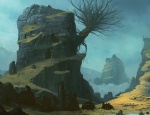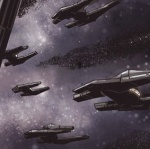Nfolgai is an arid world and the only habitable planet in the Nfolgai system. Occupied at various points throughout history by the Sith Empire, Nfolgai served as a mausoleum world for the followers of Sorzus Syn. Abandoned by the Sith as their Empire fell into chaos, the slave populations were left to fend for themselves. The world was rediscovered in 35 ABY by the One Sith, and eventually became site of one of the first clashes between their order and the Dark Jedi Brotherhood.
Description
 Woyunoks seen from Nfolgai's orbit.
Woyunoks seen from Nfolgai's orbit. The Nfolgai system is located at the edge of Sith Space, right on the edge of the Stygian Caldera. It is situated along the Descri Wris, a remote hyperlane branch connecting to the Nacha Bhelfia loop via Athiss and Ziost. The remote location of the world lead to it never being heavily populated by the Sith Empire at any point, and it remained mostly hidden and tucked away from the rest of the galaxy for thousands of years after the Empire's demise.
The stellar primary of the system was named Woyunoks, or "little one", in the ancient Sith language given its small size. A K-type main sequence star, Woyunoks was smaller and cooler than most stars with habitable planets within the territory of the old Sith Empire. Nfolgai is the third planet from the star, located at the extreme edge of the star's life zone. The inner two planets, Mysia and Triax, lack any atmosphere and are essentially barren rocks. The outermost planet, Gryin, is a large gas giant with twelve terrestrial moons. The orbit between Nfolgai and Gyrin is dominated by a dense asteroid belt. This belt is thought to be the remains of a proto-planet whose formation was prevented by Gyrin's gravitational field.
Geography
With copious mountain ranges and desolate wastelands, Nfolgai’s northern hemisphere provides little sustenance to support large populations of settlers. The northern mountain ranges stretch for thousands of kilometers, leaving terrain that offers little in the way of habitable valleys or farmable land.
 Nfolgai's arid northern region.
Nfolgai's arid northern region. The equatorial mountain ranges are older than those of the north and are consequently far less imposing. This area remains very hilly and arid. The soil, much more metallic than in the north, begins to deepen in color when compared to the sandy dust.
The south is marked with smaller, gentler mountains, and its valleys are made up entirely of jungles and still comparatively arid swampland. The largest of such valleys span for several hundred kilometers. This southern region boasts the only real farmable land over the planet's surface, but the growing season is short due to the harsh climate.
The north and south polar caps contain nearly all of the water on the planet, frozen in large glaciers. The mountains are smaller near the pole and are completely frozen over.
Climate
Between the barren wastes in the north and the dense jungles in the south, the weather in between is unpredictable at best and downright destructive and impassable at worst. The Dark Side influence can be felt in how the weather is corrupted, with random bouts of acid rain, black lightning, and other manifestations of unusual and altered states. The tall mountains of the north provide for a vast difference in air pressures and create winds that can become violent and swirl through their valleys. Frequent storms of stinging rains and deadly sand twisters rage back and forth, caused by the upheaval in the atmosphere.
There is very little water on the planet that isn’t frozen at the poles. Most of the free water is in the southern jungles and marshes, though even there it is somewhat sparse. Due to the lack of water, the flora on Nfolgai adapted to make use of the high metallic-mineral content in the soil in order to maintain their structure in the absence of water. This adaptation has left the plants themselves with very high metal content, making scanners and sensors virtually useless in the southern jungles. The more barren climate of the north offers very little in the way of flora. The plants native to this region bury their roots deep into the crust of the planet, absorbing what little water is available as well as the minerals required to sustain life.
History
Pre-Republic
 Rakatan ships used by the Sith.
Rakatan ships used by the Sith. Nfolgai was first settled by outsiders following the Rakatan invasion of Korriban and the death of the Sith King, or Sith'ari, Adas around 27,700 BBY. Using the remains of captured Rakatan ships, as well as a newfound knowledge of the Dark Side of the Force, the newly formed Empire conquered and occupied many of the worlds surrounding Korriban. This included Nfolgai and the new capital of Ziost.
Nfolgai was not settled heavily by the Empire at this point, as the stability of the central leadership was short lived. With Adas dead, there was little of the unifying authority that had allowed the Sith to fend off the Rakata. The original Empire collapsed into warring factions, eventually regressing technologically back to a state much like that which had preceded the reign of Adas. This collapse led to Nfolgai being cut off from the rest of Sith society and its small population being forced to fend for themselves.
Sith Rule
The Sith Empire began again on Korriban circa 6,900 BBY with the arrival of the Exiles, fallen Jedi who had fought against the Jedi Order at the end of the Hundred-Year Darkness and been banished from known space. The Dark Jedi arrived on a planet that was torn apart by millennia of civil war. In short order, the Jedi brought the Sith to heel. The armies of the new Empire spread out from Korriban, reconquering the worlds inhabited by the Sith twenty thousand years earlier. During the intervening years, the population of Nfolgai had increased significantly, ruled by a cabal of Kissai priests. The planet's inhabitants were routed quickly by armies of Massassi warriors, who were ruthless in their conquest. The newly conquered world was then settled anew by a wave of Sith and their slaves, including the Mrlssi, Draethos, and Humans.
After the newly anointed Sith Lords had settled on Ziost, they once again made the world the Sith capital. Sorzus Syn then began a survey of the worlds of the Empire. It was on Nfolgai that Syn encountered a Mrlssi slave, propelling her down an avenue of discovery that would track the raids of the Sith in the galaxy at large back through the millennia. Syn would eventually decide to settle on Nfolgai and use the slaves on the world to erect her temple. The Sith would eventually come to revere Syn, who is thought to be the original author of the Sith Code. The Sith came to see Nfolgai as a sacred burial world much like Korriban. Other Sith would be entombed there, often those who most closely followed Syn's path and teachings. Several other temples and tombs would be built on the planet, but none would reach the grandeur of the temple of Sorzus Syn.